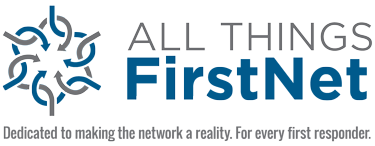By James Careless
First responders have long struggled with ‘signal dropouts’ in areas where their communications devices can’t connect to Dispatch and/or each other. They can be caused by radio waves being blocked inside buildings, hampered by hilly terrain, or just foiled by too-large distances.
In many cases, the solution to signal dropouts is more transmission power. That’s a truth that AT&T has embraced with its new suite of FirstNet MegaRange equipment. These all-in-one High Powered User Equipment (HPUE) solutions help provide stronger signals and better coverage within in-buildings, vehicles and challenging field operations. At the same time FirstNet MegaRange products have been designed to be compact, affordable, and easy to install/use. (The advantages of HPUE technology are nicely summed up by Andy Seybold in this AFTN article.)
Although AT&T is offering three distinct FirstNet MegaRange solutions — because there is no ‘one size fits all’ fix for signal dropout — they all deliver the same level of transmission improvements. Central to this is the ability of FirstNet MegaRange equipment to transmit at 1.25 watts, which is the strongest wireless signal available. Unlike AT&T, most other wireless carriers in the country max out at 0.2 watts! This means that FirstNet MegaRange equipment offers 6 times more transmission power than conventional smartphones.
This difference is no accident. One of the many things that makes HPUE/MegaRanged unique is that it is exclusive to FirstNet. As many people know, the FCC regulates LTE power output and the only LTE spectrum allowed to use the higher power is the FirstNet spectrum, Band 14. This high power is not allowed with any other wireless carrier so it is only available to public safety in the FirstNet network.
More Power = More Performance
With 1.25 watts of transmitting power, FirstNet MegaRange units provide improved uplink throughput by up to 100%. This translates into increased building penetration, allowing first responders to communicate deep inside concrete buildings, elevators, basements, and parking garages. It also means significantly increased coverage in rural and dense urban areas — both for the equipment plugged directly into MegaRange units using Ethernet cables, and those external smartphones and laptops who connect to them using Wi-Fi.
Imagine what is possible when first responders integrate MegaRange units with deployable network assets like a FirstNet Compact Rapid Deployable (CRD) or miniCRD to boost their on-scene emergency response communications. With 6 times more transmission power at their disposal, these users can maximize coverage in hard-to-reach areas, often doubling the distance of available connectivity from these range-boosters to their officers. That can be up to a full mile for miniCRD connections, and more for CRD links.
This enhanced coverage has already been proven in the field by the Bristol Kendall Fire Protection District in Yorkville, Illinois. “We have a diverse geographic area, including a river valley that impedes communication where you tend to drop off the radar for cellular communication,” said Lieutenant Humza Shamsuddin, the District’s Technology Director. “Many of these coverage gaps were addressed when the agency switched to FirstNet. In fringe network areas, FirstNet MegaRange allows us to stay connected with a higher level of reliability. The areas that we knew were dead zones for a previous carrier—magically, we didn’t really have them with FirstNet.”
Three Reliable Options
As mentioned, FirstNet MegaRange units come in three versions. All are built around the Nextivity SHIELD MegaFi router — which has been certified as ‘FirstNet Trusted’ — and come complete with power adapters (AC, DC or battery) and cellular antennas.
MegaFi Fixed is designed to improve in-building connectivity in locations such as basements, garages, subways, offices, and 9-1-1 call centers. It can be permanently installed for continuous service, in ‘hard to reach’ coverage areas that have been identified by first responder agencies.
MegaFi Mobile is designed to deliver stronger connectivity to vehicles at the edge of the network. These can include ambulances, boats and ships, buses, cars, trains, and trucks — any moving platform that relies on rooftop antennas for transmission and reception.
MegaGo comes in a suitcase for fast-deploy in-the-field support. It can improve the coverage and connectivity for first responders at an incident scene, no matter how rugged and remote. This unit’s rechargeable battery life runs to 12 hours at a time, and can be recharged while in use as long as the battery level is at 20% or higher.
“We worked closely with the FirstNet team at AT&T to develop the suite of new MegaRange solutions to meet the standards and performance levels necessary to be reliable and trusted to support our country’s most critical communications,” said Nextivity CEO Michiel Lotter. “The integration of FirstNet MegaRange technology with Nextivity experience and know-how means more reliable signals for more people in more places, when they need it the most.”
The Bottom Line
For first responders needing better connectivity and wider coverage, FirstNet MegaRange units are the signal-boosting solutions that they’ve been looking for.


Be the first to comment on "FirstNet MegaRange Delivers More Transmission Power, Wider Coverage"